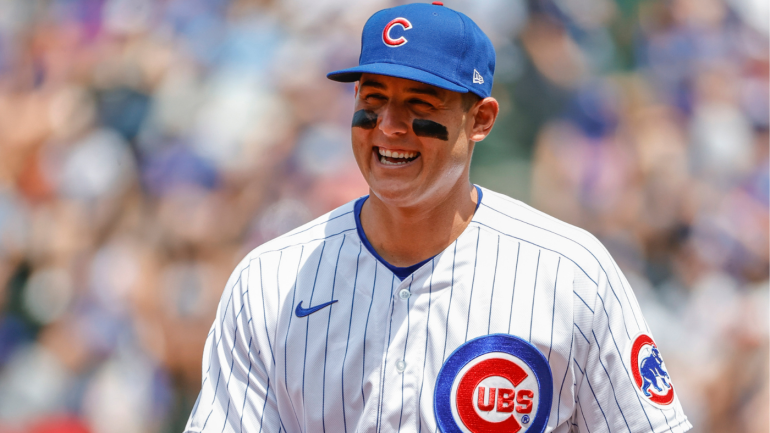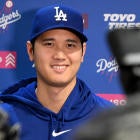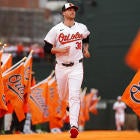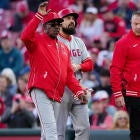
On the same day the New York Yankees announced the acquisition of slugger Joey Gallo, general manager Brian Cashman returned to the trade market for another veteran lefty bat, this time agreeing to a three-player trade with the Chicago Cubs for first baseman Anthony Rizzo. Rizzo gives the Yankees another steadying presence in the middle of their lineup, as well as a defensive upgrade at the cold corner.
As for the Cubs, they land a pair of prospects who they hope can follow in Rizzo's footsteps and become members of their next championship core. We here at CBS Sports are the judgmental kind, if little else. As such, you'll find our instant-reaction grades for both sides of this trade below. It should go without saying that this is more of an art than a science.
First, let's reprint the official terms of the deal:
- Yankees acquire: 1B Anthony Rizzo, cash considerations
- Cubs acquire: OF Kevin Alcántara, RHP Alexander Vizcaino
Now, let us proceed to the hot air and the grades.
Yankees grade: A
As we noted in the Gallo trade grades piece, the Yankees offense has underwhelmed this season. Blame it on injuries and underperformance from key contributors, but it's unacceptable that New York ranks 25th in the majors in runs scored and 13th in wRC+, a catch-all metric from FanGraphs that adjusts for ballpark (and other variables). The Yankees' collection of left-handed batters also had the worst OPS against right-handed pitchers among any team. That mark should improve now that the Yankees have Gallo and Rizzo in tow.
Rizzo, who will turn 32 in August, doesn't have Gallo's upside or team control (he'll hit free agency at year's end). He should diversify a strikeout-prone lineup a bit with his high-contact ways, as he hasn't struck out in more than 16 percent of his plate appearance since 2016. Otherwise, he still hits the baseball hard (his average exit velocity ranks in the 82nd percentile), draws walks, and plays a dandy first base. As a result, he joins the Yankees having hit .248/.346/.446 (116 OPS+) with 14 homers and 1.2 Wins Above Replacement in 92 games.
There's some risk involved with Rizzo, of course. Some interested teams had concerns about his back (he's left multiple games this season alone because of flare-ups), but the Yankees can mitigate the downside by giving him a start here or there at designated hitter. Besides, the Yankees aren't paying him anything. Instead, they followed the same blueprint they used on the Gallo trade, sending over good enough prospects to convince the Cubs to foot the bill.
It's to be seen where the Yankees go from here, but reports have them out on Colorado Rockies shortstop Trevor Story. Cashman has mostly dealt from the Nos. 6-20 range of his farm system, suggesting he has more left in his war chest if he wants to make another splash. (Credit New York's scouting and development departments for amassing the depth necessary to make such maneuvers in the first place.) The Yankees' seeming unwillingness to cross the luxury-tax line could prove to be a bigger hindrance than any kind of prospect requirement.
Whatever Cashman does or doesn't do, he's upgraded his lineup in a meaningful way. It might prove to not be enough for New York to get into the playoffs, but the Yankees have a deeper, more talented lineup, and therefore a better chance, now than they did entering the week.
Cubs grade: B
As a cold, calculated baseball trade without any additional context, the Cubs did fine here by getting two interesting prospects for a rental first baseman.
Alcántara, 19, is listed at a projectable 6-foot-6, 188 pounds. He's a safe bet to add strength over the coming years, giving him a real chance to develop well-above-average power at maturation. It's never worth reading too much into a teenager's statistics, and that's especially the case now after the havoc wreaked on development by the global pandemic. That established, Alcántara has shown a tendency to swing and miss as a professional. He'll have to keep his strikeout rate in check as he moves up the ladder, lest his hit tool fall closer to a 40 than a 50. One other factor to watch for here is whether or not he'll be able to retain enough speed to stick in center field as he adds mass. If not, there'll be even more pressure on his pop.
Vizcaino, 24, missed the start of the season with arm trouble. He's thrown six innings since returning, amassing some ugly, if meaningless numbers in that time. Vizcaino has a good fastball-changeup combination, but he'd ideally develop a better breaking ball and some additional command. He's already on the 40-player roster, so the clock is ticking. The Cubs have every reason to give him a longer leash before flipping the switch.
With additional context, this trade stinks. There are legit baseball reasons to be skeptical of Rizzo's value heading forward and blah blah blah, but it's loathsome to see one of sports' most prestigious franchises dismantle a core full of fan favorites because the owners won't pony up to keep any of them in town for market value. This won't be the last painful move the Cubs make before Friday's deadline, but it makes for an appropriate leadoff deal for what's to come.






















